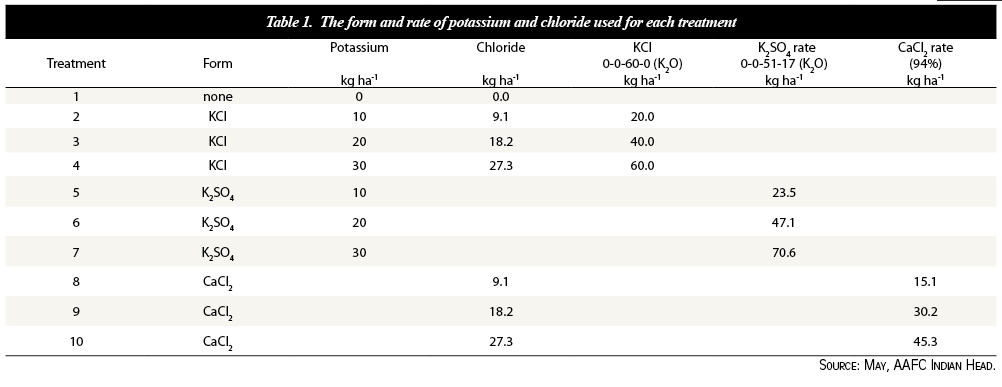
Features
Agronomy
Fertility and Nutrients
Canaryseed responds to chloride nutrition
With canaryseed growers reporting a yield response to potash fertilizer (KCl; 0-0-60), researcher Bill May at Agriculture and Agri-Food Canada’s Indian Head research centre set out to investigate the responsiveness of canaryseed to potash fertilizer, and to see if he could provide better fertility recommendations to growers based on soil test results.
April 30, 2010 By Bruce Barker
 |
|
| Growers should experiment to find out if canaryseed is responsive to chloride. Photo by Bruce Barker. |
With canaryseed growers reporting a yield response to potash fertilizer (KCl; 0-0-60), researcher Bill May at Agriculture and Agri-Food Canada’s Indian Head research centre set out to investigate the responsiveness of canaryseed to potash fertilizer, and to see if he could provide better fertility recommendations to growers based on soil test results. “Year to year variability has been a concern for canaryseed growers and we thought that potassium (K) and chloride (Cl) might be part of it,” says May.
May says that very little information is available on the requirements of canaryseed for K and Cl, but some growers had found a yield response to KCl fertilizer. To better understand the KCl response, May conducted a three-year trial from 2007 through 2009. He had five sites at Indian Head, Carry The Kettle, Regina plain, and Stewart Valley, Saskatchewan. He used three treatment rates of K and Cl in three different formulations.
The results showed that the Cl found in potash fertilizer was the nutrient providing a yield response because no response was observed to K even in fields that were rated low to moderate K in soil tests.
May reports that in 2007 the yields were on the low side due to temperature and moisture stress during seed development. At three of the five locations, which included both Carry The Kettle and Regina, a strong yield response occurred when Cl was applied. Grain yield was not affected by Cl or K applications at Stewart Valley in 2007. In 2008, both locations near Carry The Kettle showed a Cl response, which followed a similar pattern seen in 2007. There was no response at the other locations to K or Cl in 2008. In 2009, again, both sites at Carry The Kettle showed a Cl response while at Regina and Stewart Valley a weak response was observed. “We had some Cl responsive sites, some non-responsive sites and some sites that were weakly responsive,” explains May. “But if the site was responsive, it was responsive under all growing conditions.”

|

|
May explains that canaryseed growers should be aware of possible Cl deficiencies on their land and advised them to monitor Cl soil test levels. Unfortunately, at this time, the critical soil test level where canaryseed will respond to Cl is not known, so he says that farmers should conduct strip trials with Cl nutrition and soil test for Cl levels to see if they can find a correlation. “It is hard to know what the responsiveness of the soil will be until you do some of your own trials,” says May. “Spend a little on potash and find out what is happening on your own soils.”
For 2010, May is hoping to have more fields across Saskatchewan with field demonstration trials to get a better handle on what is happening with Cl nutrition, and to start to get a better handle on the critical soil test levels. He is interested in hearing from farmers who conduct their own field strip trials.
Since CaCl2 fertilizer is not commonly available and is difficult to work with, May says farmers should just use potash fertilizer instead. He suggests a Cl rate of around 10 kg per hectare (nine lbs per acre) actual Cl. In potash fertilizer, the Cl nutrient content is typically 47 percent, so 20 lbs of potash (0-0-60) fertilizer per acre would supply about 9.4 lbs actual Cl per acre.
The reward for Cl fertilization can be high. Some of May’s plots had yield responses of up to 700 lbs per acre. Still, since responsiveness is unpredictable, May recommends starting out with strip trials when adding potash fertilizer.
“Do some exploratory work on your own to find out if it is responsive to Cl fertilizer,” says May.
Funding for his research was provided by Saskatchewan Agriculture, Agriculture and Agri-Food Canada, the Canaryseed Development Commission of Saskatchewan, the International Plant Nutrients Institute and Agrium.